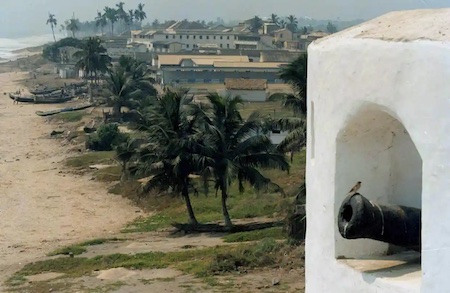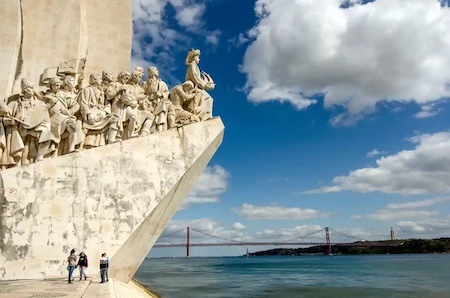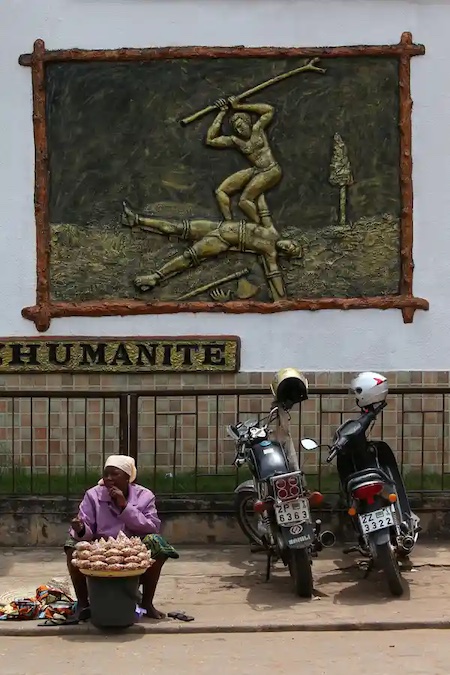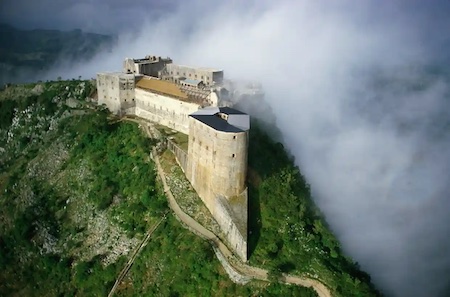|
By Howard W. Fench
from The Guardian
Monday, Nov 1, 2021
 |
| The Monument to the Discoveries in Lisbon, Portugal. Photograph: Image Broker/Rex |
How Africa was erased from the history of the modern world
The creation of the modern, interconnected world is generally credited to European pioneers. But Africa was the wellspring for almost everything they achieved – and African lives were the terrible cost
It would be unusual for a story that begins in the wrong place to arrive at the right conclusions. And so it is with the history of how the modern world was made. Traditional accounts have accorded a primacy to Europe’s 15th-century Age of Discovery, and to the maritime connection it established between west and east. Paired with this historic feat is the momentous, if accidental, discovery of what came to be known as the New World.
Other explanations for the emergence of the modern world reside in the ethics and temperament that some associate with Judeo-Christian beliefs, or with the development and spread of the scientific method, or, more chauvinistically still, with Europeans’ often-professed belief in their unique ingenuity and inventiveness. In the popular imagination, these ideas have become associated with the work ethic, individualism and entrepreneurial drive that supposedly flowed from the Protestant Reformation in places such as England and Holland.
Of course, there is no denying the significance of the voyages of mariners such as Vasco da Gama, who reached India via the Indian Ocean in 1498, Ferdinand Magellan, who travelled west to Asia, skirting the southern tip of South America, and Christopher Columbus. As the author Marie Arana has elegantly said of Columbus, when he sailed west, “he had been a medieval man from a medieval world, surrounded by medieval notions about Cyclops, pygmies, Amazons, dog-faced natives, antipodeans who walk on their heads and think with their feet – about dark-skinned, giant-eared races who inhabit the lands where gold and precious gems grow. When he stepped on to American soil, however, he did more than enter a new world: he stepped into a new age.”
Although these famous feats of discovery dominate the popular imagination, they obscure the true beginnings of the story of how the globe became permanently stitched together and thus became “modern”. If we look more closely at the evidence, it will become clear that Africa played a central role in this history. By miscasting the role of Africa, generations have been taught a profoundly misleading story about the origins of modernity.
The first impetus for the Age of Discovery was not Europe’s yearning for ties with Asia, as so many of us learned in school, but rather its centuries-old desire to forge trading ties with legendarily rich Black societies hidden away in the heart of “darkest” west Africa. Iberia’s most famous sailors cut their teeth not seeking routes to Asia, but rather plying the west African coastline. This is where they perfected techniques of mapmaking and navigation, where Spain and Portugal experimented with improved ship designs, and where Columbus came to understand the Atlantic Ocean winds and currents well enough that he would later reach the western limits of the sea with a confidence that no European had previously had before him, of being able to return home.
 |
| A fort in Elmina, Ghana, built by 15th-century European gold and slave traders. Photograph: David Guttenfelder/Associated Press
|
Well before he mounted his expeditions on behalf of Spain, Columbus, an Italian from Genoa, had sailed to Europe’s first large, fortified overseas outpost, which was located in the tropics at Elmina, in modern-day Ghana. European expeditions to west Africa in the mid-15th century were bound up in a search for gold. It was the trade in this precious metal, discovered in what is now Ghana by the Portuguese in 1471, and secured by the building of the fort at Elmina in 1482, that helped fund Vasco da Gama’s later mission of discovery to Asia. This robust new supply of gold helped make it possible for Lisbon, until then the seat of a small and impecunious European crown, to steal a march on its neighbours and radically alter the course of world history.
Bartolomeu Dias, another Portuguese explorer who knew Elmina well, rounded Africa’s Cape of Good Hope in 1488, proving the existence of a sea route to what would become known as the Indian Ocean. But no onward voyage to Asia would even be attempted for nearly a decade after that, when Da Gama finally sailed to Calicut (now known as Kozhikode in India). The teaching of history about this era of iconic discoveries is confoundingly silent not only on that decade, but on the nearly three decades between the Portuguese arrival at Elmina in 1471 and their landing in India in 1498.
It was this moment, when Europe and what is nowadays styled sub-Saharan Africa came into permanent deep contact, that laid the foundations of the modern age.
The elision of these three pivotal decades is merely one example of a centuries-long process of diminishment, trivialisation and erasure of Africans and people of African descent from the story of the modern world. It is not that the basic facts are unknown; it is that they have been siloed, overlooked or swept into dark corners. It is essential to restore key chapters such as these to their proper place of prominence in our common narrative of modernity.
Starting in the 15th century, encounters between Africans and Europeans set the most Atlantic-oriented Europeans on a path that would eventually propel their continent past the great civilisational centres of Asia and the Islamic world in wealth and power. The rise of Europe was not founded on any innate or permanent characteristics that produced superiority. To a degree that remains unrecognised, it was built on Europe’s economic and political relations with Africa. The heart of the matter here, of course, was the massive, centuries-long transatlantic trade in enslaved people who were put to work growing sugar, tobacco, cotton and other cash crops on the plantations of the New World.
 |
| The Monument to the Discoveries in Lisbon, Portugal. Photograph: Renato Granieri/Alamy |
The long thread that leads us to the present began in those three decades at the end of the 15th century, when commerce blossomed between Portugal and Africa, sending a newfound prosperity washing over what had previously been a marginal European country. It drove urbanisation in Portugal on an unprecedented scale, and created new identities that gradually freed many people from feudal ties to the land. One of these novel identities was nationhood, whose origins were bound up in questing for wealth in faraway lands, and soon thereafter in emigration and colonisation in the tropics.
As Portugal started to venture out into the world in the 1400s – and for nearly a century this meant almost exclusively to Africa – its people were among the first to make another conceptual leap. They began to think of discovery not merely as the simple act of stumbling upon assorted novelties or arriving wide-eyed in never-before-visited places, but rather as something new and more abstract. Discovery became a mindset, and this would become another cornerstone of modernity. It meant understanding that the world was infinite in its social complexity, and this required a broadening of consciousness, even amid the colossal violence and horror that accompanied this process, and an ever more systematic unmooring from provincialism.
The fateful engagement between Europe and sub-Saharan Africa produced civilisational transformations in both regions, as well as in the wider world – ones that, looking back today, produced an exceptionally crisp division between “before” and “after”.
Back then, Europeans were mindful of this reality. As late as the 1530s, well after the start of Portugal’s more famous spice trade with Asia, Lisbon still recognised Africa as the leading driver of all that was new. João de Barros, a counsellor to that country’s crown, wrote: “I do not know in this Kingdom a yoke of land, toll, tithe, excise or any other Royal tax more reliable … than the profits of commerce in Guinea.”
But as remarkable as Barros’s acknowledgment of African vitality was, his omission of slavery as a pillar of the relationship was equally notable. It may have been the first time that the centrality of Black bondage was simply passed over in an informed account of modernity in the west. It would not be the last. When Barros wrote, Portugal overwhelmingly dominated Europe’s trade in Africans, and slavery was beginning to rival gold as Portugal’s most lucrative source of African bounty. By then, it was already on its way to becoming the foundation of a new economic system based on plantation agriculture. Over time, that system would generate far more wealth for Europe than African gold or Asian silks and spices.
Sounding like an updated Barros, Malachy Postlethwayt, a leading 18th-century British expert on commerce, called the rents and revenues of plantation slave labour “the fundamental prop and support” of his country’s prosperity. He described the British empire as “a magnificent superstructure of American commerce and naval power [built] on an African foundation”. Around the same time, an equally prominent French thinker, Guillaume-Thomas-François de Raynal, described Europe’s plantations worked by African enslaved people as “the principal cause of the rapid motion which now agitates the universe”. Daniel Defoe, the English author of Robinson Crusoe, but also a trader, pamphleteer and spy, bested both when he wrote: “No African trade, no negroes; no negroes, no sugars, gingers, indicoes [sic] etc; no sugar etc, no islands, no continent; no continent, no trade.”
Postlethwayt, Raynal and Defoe were surely right, even if they did not comprehend all of the reasons why. More than any other part of the world, Africa has been the linchpin of the machine of modernity. Without African peoples trafficked from its shores, the Americas would have counted for little in the ascendance of the west. African labour, in the form of enslaved people, was what made the very development of the Americas possible. Without it, Europe’s colonial projects in the New World are unimaginable.
Through the development of plantation agriculture and a succession of history-altering commercial crops – tobacco, coffee, cacao, indigo, rice and, above all, sugar – Europe’s deep and often brutal ties with Africa drove the birth of a truly global capitalist economy. Slave-grown sugar hastened the coming together of the processes we call industrialisation. It radically transformed diets, making possible much higher worker productivity. And in doing so, sugar revolutionised European society.
 |
| A monument to slavery at a museum in Porto-Novo, Benin. Photograph: Afolabi Sotunde/Reuters |
In sugar’s wake, cotton grown by enslaved people in the American south helped launch formal industrialisation, along with a second wave of consumerism. Abundant and varied clothing for the masses became a reality for the first time in human history. The scale of the American antebellum cotton boom, which made this possible, was nothing short of astonishing. The value derived from the trade and ownership of enslaved people in the US alone – as distinct from the cotton and other products they produced – was greater than that of all of the country’s factories, railroads and canals combined.
Now-forgotten European contests over control of the African bounty partly built the modern world, by strengthening fixed national allegiances. Spain and Portugal waged fierce naval battles in west Africa over access to gold. Holland and Portugal, then unified with Spain, fought something little short of a world war in the 17th century in present-day Congo and Angola, vying for control of trade in the richest sources of enslaved people in Africa. On the far side of the Atlantic, Brazil – the biggest producer of slave-grown sugar in the early 17th century – was caught up in this same struggle, and repeatedly changed hands. Later in that same century, England fought Spain over control of the Caribbean.
Why did faraway powers contend so fiercely over such things? Tiny Barbados provides an answer. By the mid-1660s, just three decades or so after England initiated an African slave-labour model for its plantations there – one that was first implemented in the Portuguese colony of São Tomé little more than a century earlier – sugar from Barbados was worth more than the metal exports of all of Spanish America.
Amid this story of military struggles for control of land and slaves, and of the economic miracles they produced, another kind of conflict is visible: a war on Black people themselves. This involved the consistent pursuit of strategies for beating Africans into submission, for making them enslave one another, and for recruiting Black people as proxies and auxiliaries, whether to secure territories from native populations of the New World or joust with European rivals in the Americas.
To say this is not to deprive Africans of agency. The impact of this warfare on Africa’s subsequent development, however, has been immeasurable. Nowadays, the consensus estimate on the numbers of Africans brought to the Americas hovers about 12 million. Lost in this atrocious but far too neat accounting is the likelihood that another 6 million Africans were killed in or near their homelands during the hunt for slaves, before they could be placed in chains. Estimates vary, but between 5% and 40% perished during brutal overland treks to the coast, or while being held, often for months, in barracoons, or holding pens, as they awaited embarkation on slave ships. And another 10% of those who were taken aboard died at sea during an Atlantic transit that constituted an extreme physical and psychological test for all those who were subjected to it. When one considers that Africa’s total population in the mid-19th century was probably about 100 million, one begins to gauge the enormity of the demographic assault that the slave trade represented.
This war on Black people raged just as fiercely on the western shores of the Atlantic, as did the resistance. Societies of runaways bent on freedom came together in many places, from Brazil and Jamaica to Florida. It is often remarked that Africans themselves sold enslaved people to Europeans. What is less well known is that in many parts of Africa, such as the Kingdom of Kongo and Benin, Africans fought to end the trade in human beings once they understood its full impact on their own societies. Enslaved people resisted in numerous shipboard revolts, or by simply taking their own lives at sea rather than submit to bondage.
In most of the New World plantation societies, the average remaining lifespan of trafficked Black people was reckoned at seven years or less. In 1751, an English planter on Antigua summed up the prevailing slaveowner sentiment this way: “It was cheaper to work slaves to the utmost, and by the little fare and hard usage, to wear them out before they become useless, and unable to do service; and then to buy new ones to fill up their places.”
I was lucky to be introduced to Africa while still a university student, first as an enthralled visitor during college breaks, and later living there for six years after graduation. I cut my teeth as a journalist writing about Africa and travelling widely, and I married a woman who had grown up in Ivory Coast, but whose family was from a nearby part of Ghana. I wasn’t at all aware of it at the time, but it was within a few miles of her ancestral village that Europeans first stumbled upon the abundant sources of west African gold that they had been searching for feverishly for several decades in the 15th century. It was a discovery that changed the world.
I left west Africa to join the New York Times in 1986. Three years later, my first assignment as a foreign correspondent was to cover the Caribbean basin. Here were gathered some of the most important staging areas for subsequent global transformations. Specialists aside, few imagine that islands like Barbados and Jamaica were far more important in their day than were the English colonies that would become the United States. The nation now known as Haiti most of all. In the 18th century it became the richest colony in history, and in the 19th, by dint of its slave population’s successful revolution, Haiti rivalled the US in terms of its influence on the world, notably in helping fulfil the most fundamental Enlightenment value of all: ending slavery.
Now and then during my time in the Caribbean, I could see glimmers of this region’s extraordinary role in our global narrative. One one occasion, in the Dominican Republic, I stood knee-deep in seawater witnessing an archaeological dig that sought to identify a wreck from Columbus’s first voyage. Another time, I hiked a verdant peak in northern Haiti where Henri Christophe, that country’s early Black leader, built a formidable fortress, the Citadelle Laferrière, arming it with 365 cannon to defend the country’s hard-won independence from France. Other hints came when I wandered into the mountains and rainforests of Jamaica and Suriname, respectively, and was thrilled to be able to make myself understood speaking bits of Twi (the lingua franca of Ghana, which I had learned while courting my wife) as I spoke with the descendants of proud runaway slave communities known as maroons. But back then, I still had no big picture in mind; like most correspondents, I was too busy following the news to pursue sweeping historical connections very far.
 |
| The Citadelle Laferrière in Haiti, built by the former slave and revolutionary leader Henri Christophe. Photograph: National Geographic/Getty Images |
Even knowing the silence and enforced ignorance that surround the central contribution of Africa and Africans to the making of the modern world, I have often been surprised by just how difficult it can be to access some of the physical traces of this history, or to find local forms of remembrance that raise this African role to its proper dimension. I have seen this in many places that have shaped our common history, such as Nigeria and the Democratic Republic of the Congo, where the publicly established sites of Atlantic memory are few. I saw it in São Tomé, the island where the slave-plantation-complex model that would drive wealth creation in the North Atlantic for four centuries appeared for the first time, fully formed – a fact for which there is nary a plaque or commemoration.
My biggest surprise came in Barbados, whose slave-produced sugar, arguably more than any other place on earth, helped seal England’s ascension in the 17th century. I visited the island not long ago, determined to find as many traces of this legacy as possible, only to discover how thoroughly they had been hidden or effaced. Among my top priorities was to visit one of the largest slave cemeteries anywhere in the hemisphere, which included the excavated remains of nearly 600 people. It took me several attempts just to find the cemetery, which had no signage from any public road. Few local residents seemed aware of its historical importance, or even of its existence.
All I discovered when I drove down a bumpy dirt road, proceeding as far as I could until instinct told me to get out and walk, was a modest clearing alongside an active plantation whose cane had grown as tall as I am. There was a faded sign attached to a rusty iron post. It proclaimed the site to be part of something called “The Slave Route”, but it provided no further information. With the sun racing downward in the western sky, I paced about, snapped a few photographs, and then finally collected myself as the wind whistled through the cane. I tried mightily to conjure some sense of the horrors that had transpired nearby, and of the abundant wealth and pleasure that the sweat of the dead had procured for others.
But the most egregious forms of historical erasure do not involve an assortment of mostly small, former slave-trading or plantation societies scattered around the Atlantic Rim. The most important site of erasure, by far, has been the minds of people in the rich world. As I write these words, the US and some other North Atlantic communities, from Richmond, Virginia, to Bristol, England, have recently experienced extraordinary moments of iconoclasm. We have seen the pulling down of statues of people who were long perceived to be heroes of imperial and economic systems built on the violent exploitation of people extracted from Africa.
A sculpture called Gilt of Cain, by artist Michael Visocchi and poet Lemn Sissay, commemorating the 2007 bicentenary of the abolition of the transatlantic slave trade. Fen Court, London
When will Britain face up to its crimes against humanity?
Read more
For these gestures to have more lasting meaning, an even bigger and more challenging task remains for us. It requires that we transform how we understand the history of the last six centuries and, specifically, of Africa’s central role in making possible nearly everything that is today familiar to us. This will involve rewriting school lessons about history just as much as it will require the reinvention of university curricula. It will challenge journalists to rethink the way we describe and explain the world we all inhabit. It will require all of us to re-examine what we know or think we know about how the present-day world was built, and to begin incorporating this new understanding into our everyday discussions.
In this task, we can no longer hide behind ignorance. Nearly a century ago, WEB Du Bois had already affirmed much of what we needed to know on this topic. “It was black labour that established the modern world commerce, which began first as a commerce in the bodies of the slaves themselves,” he wrote. Now is the time to finally acknowledge this.
Adapted from Born in Blackness: Africa, Africans, and the Making of the Modern World, 1471 to the Second World War, by Howard W French, published by WW Norton & Co. **
[** This book is highly recommended - prh, ed.]
Source URL
|
 Print This Print This

|

